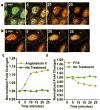Monitoring focal adhesion kinase phosphorylation dynamics in live cells
- PMID: 28589989
- PMCID: PMC5531600
- DOI: 10.1039/c7an00471k
Monitoring focal adhesion kinase phosphorylation dynamics in live cells
Abstract
Focal adhesion kinase (FAK) is a cytoplasmic non-receptor tyrosine kinase essential for a diverse set of cellular functions. Current methods for monitoring FAK activity in response to an extracellular stimulus lack spatiotemporal resolution and/or the ability to perform multiplex detection. Here we report on a novel approach to monitor the real-time kinase phosphorylation activity of FAK in live single cells by fluorescence lifetime imaging.
Conflict of interest statement
The authors declare no competing financial interest.
Figures




Similar articles
-
Cellular settings mediating Src Substrate switching between focal adhesion kinase tyrosine 861 and CUB-domain-containing protein 1 (CDCP1) tyrosine 734.J Biol Chem. 2011 Dec 9;286(49):42303-42315. doi: 10.1074/jbc.M111.227462. Epub 2011 Oct 12. J Biol Chem. 2011. PMID: 21994943 Free PMC article.
-
Hepatocyte growth factor induces ERK-dependent paxillin phosphorylation and regulates paxillin-focal adhesion kinase association.J Biol Chem. 2002 Mar 22;277(12):10452-8. doi: 10.1074/jbc.M107551200. Epub 2002 Jan 9. J Biol Chem. 2002. PMID: 11784715
-
Vascular endothelial growth factor regulates focal adhesion assembly in human brain microvascular endothelial cells through activation of the focal adhesion kinase and related adhesion focal tyrosine kinase.J Biol Chem. 2003 Sep 19;278(38):36661-8. doi: 10.1074/jbc.M301253200. Epub 2003 Jul 3. J Biol Chem. 2003. PMID: 12844492
-
Focal adhesion kinase: exploring Fak structure to gain insight into function.Int Rev Cell Mol Biol. 2011;288:185-225. doi: 10.1016/B978-0-12-386041-5.00005-4. Int Rev Cell Mol Biol. 2011. PMID: 21482413 Review.
-
Focal adhesion kinase signaling in unexpected places.Curr Opin Cell Biol. 2017 Apr;45:24-30. doi: 10.1016/j.ceb.2017.01.003. Epub 2017 Feb 16. Curr Opin Cell Biol. 2017. PMID: 28213315 Free PMC article. Review.
Cited by
-
Modulation of Gene Silencing by Cdc7p via H4 K16 Acetylation and Phosphorylation of Chromatin Assembly Factor CAF-1 in Saccharomyces cerevisiae.Genetics. 2019 Apr;211(4):1219-1237. doi: 10.1534/genetics.118.301858. Epub 2019 Feb 6. Genetics. 2019. PMID: 30728156 Free PMC article.
-
Hydrogel Network Dynamics Regulate Vascular Morphogenesis.Cell Stem Cell. 2020 Nov 5;27(5):798-812.e6. doi: 10.1016/j.stem.2020.08.005. Epub 2020 Sep 14. Cell Stem Cell. 2020. PMID: 32931729 Free PMC article.
-
Bioinspired glycosaminoglycan hydrogels via click chemistry for 3D dynamic cell encapsulation.J Appl Polym Sci. 2019 Feb 5;136(5):47212. doi: 10.1002/app.47212. Epub 2018 Nov 1. J Appl Polym Sci. 2019. PMID: 31534270 Free PMC article.
-
Multiplexable fluorescence lifetime imaging (FLIM) probes for Abl and Src-family kinases.Chem Commun (Camb). 2020 Nov 11;56(87):13409-13412. doi: 10.1039/d0cc05030j. Epub 2020 Oct 9. Chem Commun (Camb). 2020. PMID: 33035286 Free PMC article.
-
A luciferase fragment complementation assay to detect focal adhesion kinase (FAK) signaling events.Heliyon. 2023 Apr 5;9(4):e15282. doi: 10.1016/j.heliyon.2023.e15282. eCollection 2023 Apr. Heliyon. 2023. PMID: 37089315 Free PMC article.
References
-
- Kritikou E. Nature reviews. Molecular cell biology. 2009;10:3–3.
-
- Farge E. Current topics in developmental biology. 2011;95:243–265. - PubMed
MeSH terms
Substances
Grants and funding
LinkOut - more resources
Full Text Sources
Other Literature Sources
Miscellaneous

